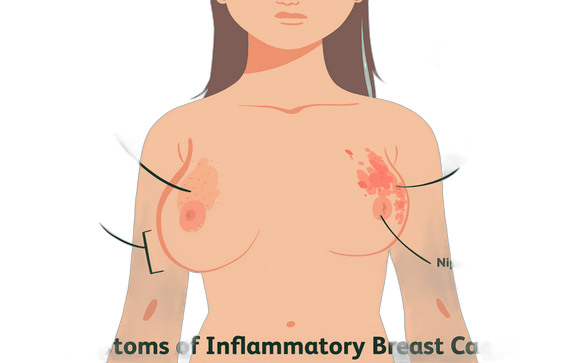Visual Stories: Understanding IBC Through Powerful Images
Visual Stories: Understanding IBC Through Powerful Images
Visual Stories: Understanding IBC Through Powerful Images
Inflammatory breast cancer (IBC) is one of the most scary types of breast cancer, often giving special problems for people and their families. Not like other kinds of breast cancer, IBC can grow fast, often without the usual lumps that many think of with the illness. This quick growth can make waiting diagnoses, leaving patients feeling alone and stressed. The emotional side is big, as people go through both the body problems of their sickness but also the mind feelings of such a life-changing diagnosis.
Pictures tell important stories about the IBC experience. Strong pictures can say more than words, showing the real feelings and things faced by those affected: troubled patients. IBC breast cancer pictures work as powerful reminders of strength, fight, and dreams. They help make a clear picture of what living with this sickness really looks like, increasing understanding and caring among caregivers, medical people, and the public.
While you read this article, you’ll see how pictures not only make more people know about IBC but also pull us all together in the shared fight against inflammatory breast cancer. Why not join us as we dive into these moving stories and the important part they play in making awareness and support within the community: why not?
Understanding Inflammatory breast cancer
Inflammatory breast cancer (IBC) is a rare and scary type of breast cancer that stands out from more common types, like ductal or lobular carcinoma. Not like these other cancers, IBC does not usually show as a set bump; instead it shows with visible skin swaps and swellings.
This different feature can make diagnosis take longer time, as the symptoms might be seen as infections or other smaller bad problems. People might see there breast skin getting red, swollen, or warm, and sometimes, the skin might get a look like an orange, called “peau d’orange.” Knowing these special signs is important for both people and healthcare workers to make sure quick seeing and action.
The symptoms of IBC can change a lot from those of other breast cancers, making awareness a must. Usual signs include fast changes in breast size or form, never-ending itching or pain in the breast, and the look of small bumps on the skin. This difference is key not only for people but also for caregivers and doctors who are working through the puzzles of diagnosis and care.
For example, while a bump in the breast might make quick checking for more usual types of breast cancer, the softer signs of IBC can be easily missed. This fact shows the weight of schooling and picturing—like IBC breast cancer photos—to better know and spot this hard disease.
As we look deeper into the patient stories touched by IBC, it becomes obvious that the emotional impact reaches beyond the body signs. Many report feelings of being lost and upset due to the unusual look of their situation. The rush with which IBC comes can leave people and there loved ones wrestling with many faces of feelings, from worry to strength as they stand up for their health.
By sharing photos that show the walk through diagnosis, care, and getting better, we can make a bigger knowing of the troubles faced by those fighting IBC. These photos act as mighty stools that behind every diagnosis is a one-of-a-kind story full of toughness and hope.
The Emotional Impact of IBC
The feeling trip of those hearing they have inflammatory breast cancer (IBC) is often as tricky and hard as the health sides of the disease itself. Not like more common types of breast cancer, IBC gives special feeling challenges due to its scary side and quick going ahead.
People often feel lost, worried, and alone as they move through their diagnosis. Caregivers, too, feel a deep heavy heart, fighting with the not knowing of there loved one’s what-next while trying to give steady help. This shared time can make a strong link, yet it also asks a lot of feeling toughness from both sides. What do we think the key takeaway to be?
Many people say going through IBC is like an emotions rollercoaster. Take Sarah, for example; at first, she thought her IBC signs were just age things. But, when doctor told her IBC, she had disbelief, followed by a super strong need to fight. Her journey shows so many feelings people have: from shock, fear to hope and determination as they start treatment. In similar way, caregivers like Mark often feel helpless. Like, he shared so importance of talking with others in support groups, helped them feel and share their feelings in safe spaces.
Stories from people facing IBC tell about how sharing their journey helps get awareness about IBC out there. Jennifer’s blog, for example tells her fight with IBC and not just helps others feel not alone but teach them too. Through her honest write on treatments and hard times, she’s inspiring. You’ve got to think—each diagnose has wonderful story full of strength, courage and desire for understanding—for both patients and caregivers.
The emotional hit of IBC affects more than one person; it touches even whole communities, highlighting how important talking about breast cancer is. By telling their travel through social media, art or events—patients and caregivers can explain the real been-there difficulties of IBC as they push for kindness and understanding among everyone. This group storytelling ups awareness, paving paths to more understanding of all those feelings with aggressive cancer.
Visual images play special roles in health care, especially for talking and teaching quite complicated illness like inflammatory breast cancer (IBC). Pictures go past just words and tell things harder to put into sentences. For any patient and caring person dealing with IBC, great images can bring others together and recognize them selves. IBC pictures talk about what changes look like so others know what to notice and talk to doctors quicker.
Additionally, visual stories share feelings of been-there through cancer days. A photo story of woman hug hugging family during treatment shows not only a battle but also needed loving circle. Images like these can make people deeply feel sympathy, making them know real parts of life with IBC. Does this make people interact better about the struggle?
These image stories do more than just show individual emotions: they impact how world see IBC and even push people to look for better solutions. When collecting groups share pictures through social media or community stuff: the story made can stress why research and change should happen. Thinking of how this visual power can start changes in understanding leads to how important connecting these journeys are.
Visual images do not just help get known about sickness like IBC, it connects people through experiences and simple shared stories. While looking into more ways we use pictures for health issues, we should think upon how greatly images can connect us—to one another and different shared lives. So doesn’t this help in fostering a friendly, understanding climate for everyone?
Showing IBC Breast Cancer Pics
Telling stories with pictures is really important to show the special journey of people with inflammatory breast cancer (IBC). With a set of strong images, we see the hard truths faced by folks at different times of their trip with cancer. Every photo shares a tale—whether it’s the first hints of IBC or what patients go through during treatment, not to mention the bravery shown by survivors. These photos don’t just represent the disease: they’re also reminders of the strong courage people show in their fight with this tough form of breast cancer.
One powerful picture shows a close-up of a lady’s chest, showing the typical redness and swelling of IBC. This image, helps to raise knowing about the symptoms that set IBC apart from other breast cancer. It points out why catching these signs early and getting medical help fast is super important. Along with this picture could be stories from survivors saying how finding out early gave them better options, reminding us that knowing your own body can really save lives.
Another touching image shows a patient getting chemotherapy, surrounded by there close ones. The look on their faces shows hope and sadness, showing how important the emotional support is when you’re getting treated. This photo is proof of the strong bonds made in tough times and highlights how important caregivers’ role is in getting better. By pairing these pictures with talks from patients and caregivers, we not only make the medical parts of IBC more human, but we also make a sense of family among those facing the same ordeal.
Lastly, an positive photo shows a group of IBC heroes proudly telling their tales at a local event to raise awareness. Their smiles shine hope and strength, showing the wins you can have after a diagnosis. This picture is important because it shows how survivor stories can give hope to other people dealing with their own struggles. By showing these images and stories, we help make a space where people talk and understand more, and maybe this helps get people more involved and concerned.
Showing IBC breast cancer pictures is a key way to make more people aware and teach them about this intense form of cancer. Unlike the usual kinds of breast cancer IBC is often not found until it’s really advanced, so knowing early on is super important for better chances.
By showing strong pictures that show the physical and emotional truths of IBC . We can show the special difficulties faced by diagnosed persons. These pictures not only help clear up the confusion about the issue but also remind us that breast cancer can show up in many ways, some less known.
Visual stories have an unmatchable power to grow understanding and ties in the community. When people see real stories of IBC—whether it’s someone getting treatment, a helper giving care, or a family living through it together—they feel more sympathy with the feelings shown.
Like, a simply photo of someone in a weak moment during a treatment can make folks feel compassion and comprehension, making them more likely to reach out to the IBC group in caring ways. These feelings can move people to become voice pieces, like sharing their own stories or backing up actions to spread understanding.
Moreover, visual story telling can drive people to take steps and back research, and learning. When people see the clear realities through IBC breast cancer images, they might feel like giving to fundraising or joining in awareness activities. Online spaces have made this effect bigger fastly, letting these stories reach more people quick.
One photo shared on the web can start talks that lead to more giving for study or taking part in local doings to help those with IBC. The ripple waves of sharing these powerful pictures can grow a neighborhood that is informed, caring, and actively trying to make change. What do you think about all this?
In the end, spreading knowledge through visual storytelling isn’t only about showing pics; it’s about making a movement toward knowing and kindness. By using IBC breast cancer images, we can close gaps in knowledge, build friendly groups, and speak up for better help and treatment for those touched by this hard sickness. Every picture tells a tale, and through these stories, we can together work toward a tomorrow where everyone touched by IBC feels noticed, helped, and strong.
Help for Patients and Caregivers
Trying to understand the tough details of inflammatory breast cancer (IBC) can be too much for both patients and their helpers. Luckily, there’s many groups and clubs who are all about spreading knowledge, giving info, and helping emotionally to those hit by this rough breast cancer type.
One great group is the Inflammatory Breast Cancer Research Foundation (IBCRF), which does research, spreads public info, and gives super-important stuff to people. Their site has learning books, survivor tales, and details on trials that help patients pick their care.
Another big help is the IBC Network Foundation, which gives learning content and also, builds a caring community for patients and helpers. They have online support groups and shows that help people connect who’re facing the same issues. Joining these groups can give emotional rest and useful tips, as members talk about their tales and ways to manage. Plus, social media has become super important in linking patients with support groups – with hashtags like #IBCawareness bringing people together for common knowing.
For those wanting more to read, there is lots of books and picture resources that talk about living with IBC. “Inflammatory Breast Cancer: A Guide for Patients” by Dr. Susan M. Love is a great start, giving an all-round view of finding out, fixing choices, and tales from people. Also, videos like “The Silent Killer: Inflammatory Breast Cancer” not only teach watchers about the illness but capture the emotional path of patients with strong pictures and talks.
Adding these helps in your ride can make both patients and helpers stronger, giving them the info and support they need to face IBC issues. By using what these groups know and joining with other people’s stories, a hopeful look can be found, and resilience while fighting for more knowing of this often-missed cancer.
Inflammatory Breast Cancer Homeopathic medicines
Homeopathic treatment of Inflammatory Breast Cancer seeks complete patient health improvement by addressing symptoms beyond the disease boundaries. Physicians often investigate the use of Phytolacca and Belladonna to relieve pain and swelling in patients which constitutes a comprehensive approach for supporting biological healing processes. The natural remedies serve as additional support to conventional treatments by boosting immunity and decreasing severe therapy side effects which results in maintaining equilibrium throughout the difficult period.
The remedy Ignatia is among the homeopathic solutions that help manage emotional challenges and psychological distress experienced by IBC patients. Homeopathic treatment delivers customized therapeutic approaches which lead patients to take active part in their healing process with an environment that supports their individual experiences and emotional needs. The integration of these alternative therapies into IBC visualization expands the knowledge of patient care and reveals methods for individuals to become stronger through hardship.
Visuals in Cancer Learning
Looking to the future, changes in storytelling with pictures are going to change how we see cancer and help those with it. With tech growing, especially in online stuff, we see and share experiences about inflammatory breast cancer (IBC) is changing. Virtual reality gives strong adventures that let watchers step into the lives of patients and helpers, giving more understanding of what those hit by IBC go through. This kind of story can break blocks, letting folks connect with the hard parts of breast cancer in ways regular methods don’t hit.
Social media is important in all this change, being strong tools to spread knowledge using pics. Hashtags like #IBCawareness and #BreastCancerStories have gotten popular, making groups where people can tell there own stories using interesting IBC breast cancer images. These show not only tough moments and wins of patients but also make the stats about this strong breast cancer seem more real. By telling personal tales visually, advocates can reach lots more folks, getting talks started and supporting help for stuff about IBC.
Also, team-ups between health workers and picture artists are opening new ways for showing things. Art shows and projects all about IBC are being put on at town events and sites, capturing patient stories while teaching others about the disease. Such steps close the gap between medical knowing and personal stories, showing that pictures can bring care and push action in people.
In this fast digital change age, what we can do with pictures in knowing about cancer is big. As we keep using picture power through social media and cool stories, we can make a world that’s more informed and caring. So, what do you think? Where can these efforts lead us in making everyone understand and care more about those battling IBC?
The visuals we choose to amplify patients’ stories create both advocacy support and environments with thriving empathy which leads to increased awareness with improved resources for IBC patients.
Conclusion: The Power of Visual Stories in IBC Awareness
The visual presentation of IBC information provides essential knowledge about the inflammatory breast cancer disease. The distinctive obstacles that patients with their families experience receive clear exposure in these visual presentations.
Association photographs of IBC breast cancer show both the tangible symptoms of this disease and the entire emotional experience of patients. The presented images help people empathize better and build stronger ties among community members.
The effort to circulate transformative visual storytelling will create more understanding and aid those impacted by IBC. We should promote the sharing of these stories through a wide network of people. When we work together we can change the public understanding of IBC while offering mutual encouragement and emotional strength to patients moving through their treatment.
inflammatory breast cancer, visual storytelling, patient journeys, emotional impact, awareness, breast cancer education, diagnosis, symptoms, treatment options, survivor stories,
breast cancer patients, caregivers, medical professionals, healthcare advocates, general public,






[…] Previous […]
[…] guide about healing and getting better during grief. From talking about grief stages to giving practical tips for taking care of yourself and maybe even getting some outside help, this article is all about […]
На этом сайте можно найти свежие новости Краснодара.
Здесь размещены главные новости города, обзоры и важные обновления.
Следите за городских новостей и получайте только проверенные данные.
Если вам интересно, что нового в Краснодаре, заглядывайте сюда регулярно!
https://rftimes.ru/
This website, you can discover a wide selection of slot machines from top providers.
Visitors can experience retro-style games as well as new-generation slots with high-quality visuals and interactive gameplay.
Whether you’re a beginner or a seasoned gamer, there’s always a slot to match your mood.
slot casino
Each title are instantly accessible round the clock and optimized for laptops and smartphones alike.
No download is required, so you can jump into the action right away.
Platform layout is intuitive, making it quick to browse the collection.
Register now, and enjoy the world of online slots!
This website, you can discover a great variety of online slots from top providers.
Players can try out classic slots as well as feature-packed games with vivid animation and exciting features.
Even if you’re new or a casino enthusiast, there’s always a slot to match your mood.
play casino
The games are ready to play round the clock and compatible with desktop computers and smartphones alike.
No download is required, so you can get started without hassle.
The interface is easy to use, making it convenient to browse the collection.
Join the fun, and dive into the excitement of spinning reels!
Автоюрист в Санкт-Петербурге:
География: все районы СПб и пригороды Ленинградской области.
Услуги:
Оспаривание лишения прав;
Экспертиза схем аварий на сложных развязках;
Помощь в возврате изъятого авто со штрафстоянки.
Автоюристы в спб
Факты: работаем с 2015 года.
https://avtoyuristvspb.ru/
FilmHub is a resource for movie enthusiasts who want organized, theme-based lists.
What’s inside:
10 titles per list: From time-travel adventures to movies for rainy days.
Where to watch: Direct links to free platforms.
Trailers & clips: Get a taste before watching.
Film stills: Perfect for social media shares.
No sign-up — just movies curated for you.
Explore unique genres at https://phijkchu.com/a/cine_picker/video-channels